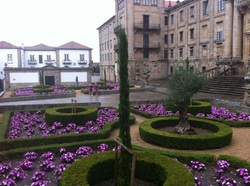 See photo gallery.I stayed a week in Santiago de Compostela. Before taking a plane to Paris, I visited the cathedral a final time. I was still sore about not getting to see the botofumeiro swing, about not getting to touch the Tree of Jesse, and about not getting to go head-to-head with Santos dos Croques, but I had yet to visit the apostle’s crypt, to pay my respects, and to leave my friend’s prayer intentions that I had carried to Santiago on her behalf. Furthermore, I had something that I wanted to say to the apostle. I wanted to tell him that, once and for all, I was going stop acting like I was a scorned object; that I was going to leave the past in Santiago; and that I was going to begin being the person of dignity and grace whom I hoped I really was. After revisiting the Portico de Gloria’s central column, I shuffled in a slow-moving line to the high alter at the other end of the church, where situated above the table was a gilded statue of Saint James. I waited my turn to go through the small doorway on the side and up the narrow stairs into the passageway behind the statue where pilgrims hug the saint in gratitude, un abrazo por el apostol. Thank you for the safe journey, I practiced in my mind. The couple ahead of me made their way up the stairs. I just want to say, I continued in my head, that when I leave Santiago-- Two elderly ladies behind me kissed their fingers then reached past me to touch the doorway. I’m going to stop giving off negative energies. Lady Number One bumped me with her bag. I’m going to start smiling and be kind. A third elderly lady pushed past me to press another kissed-on finger against the doorway. I’m going to stop caring so ridiculously about how others react to me. The girl ahead of me topped the tiny set of stairs. I’m going to stop saying ‘I’m sorry’ for every little thing. The girl ahead of me sneaked a picture with a flash. I’m going to stop being so self-deprecating. Lady Number One nudged me to go up. Um. I stepped through the door and onto the pretty set of stairs. The girl ahead of me gave the jewel-cloaked saint a quick hug then wondered why I was holding up the line. I stepped onto the top step then into the narrow passageway. Uh, oh. My mind went blank. I put my arms around the metal statue, but I could not remember what I wanted to say. Um. I pressed my cheek against his shoulder and tried harder to remember. I, uh, I, just. Lady Number One topped the stairs. I’m blowing it. I’m blowing it. Lady Number Two stopped behind her. A tear rolled off my chin and plopped onto my boot. And that was that. I descended the exiting staircase and followed an arrow that pointed to another narrow chamber below. The passageway opened into a small, low-ceilinged room. Behind protective bars lay a small silver coffin. Within it were the bones of Saint James. A couple of pilgrims and a few tourists looked at each other in silence then watched me as I tiptoed forward and slipped the envelope with my friend’s prayers through the bars as she had asked me to do. I hoped they did not think that I was littering; there, of all places. Relieved of my burden, I walked to the room’s far wall and stood awhile, meditating on the apostle’s ministry and recovering from my When-Do-We-Get-to-See-Santa-Clause disappointment upstairs. The room filled quickly. A Spanish woman said a few words about the bones having been authenticated in 1884 by Pope Leo XIII then the room emptied. And that was that. The crowd swept me out of the cathedral and back into the plaza, where, one last time, I passed the fountain and, ahead, the azabache venders to my right. Then I climbed upon one of the giant Praza da Inmaculada steps and just sat there, listening to the street performers play their stringed instruments and flutes, letting my eyes adjust to the sunlight, and collecting my final thoughts about my bipolar Camino experience. On the Camino— that awkward, surreal microcosm, I had wrangled the details of a stripped-down life, had dealt with pain and homesickness, and had appreciated tiny surprises and funny moments. I had seen myself as I really was, and I had seen life in its fragility and finiteness. I had not had a lot of grand epiphanies, nor had I encountered cinematic, ecstatic truths. But there had been some breakthroughs: Intellectually, I had diminished the dogmatic assurance, which previously had narrowed my mind against speculation. I radically had questioned and revised my own thinking and even had allowed myself sometimes to think heretically. I had realized how arrogant I have been to summarily dismiss ideas that have influenced careful thinkers from the past and present; and I had hoped all the more that I would never willfully shut off challenging questions by prejudging them; mock other points of view without investigating them; hold onto beliefs regardless of the facts; or close my mind to the possibilities of error or enlightenment. Spiritually, I had grown closer to God Who helped me to not feel so alone and to believe in myself; Who reunited the being-I-am with the being-I-wished-to-be; Who challenged me to seek ideals that lend me dignity; and Who showed me how my securities as well as my insecurities have prevented me from loving. Through the various stages of this difficult journey, I grew to have faith that I might be transformed into an authentic, virtuous, loving person, who is at ease with her self and with others; who takes the right risks; who has forgotten the past; who lives in the present; and who projects a hopeful future. In the end, I resolved to never be a person who distinguishes between human beings, both for the sake of brotherly love and because such distinctions yield spiritual impoverishment; to be fair and free in my dealings with others; and, above all, to serve coffee with a tiny spoon.
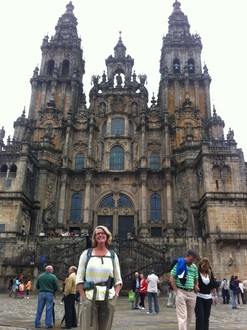 See photo gallery. I tried hard to experience the day in its true form-- to let it be what it really was and to honor and accept my individual reaction. I knew from Brierley's book that there was a good chance I might feel disappointed when I got to the Cathedral. I was expecting that feeling. What I was not expecting was the plethora of other emotions. The day started good. Everyone was up and out of the albergue at Monte del Gozo later than usual. There was no rush with only 4.7 kilometers to go. All just needed to make it to the cathedral in time for the Pilgrims' Mass at noon. It was raining and foggy when I left. I put on my rain jacket, tied the hood, then covered my backpack with its rain cover. I walked back up the hill to take another look at the Monte del Gozo monument, then walked around a kiosk to get back on the road to Santiago. A scruffy dog belonging to the kiosk vender, came up to me. I pet it while its owner smiled and said some jolly Spanish thing to me. A serious-looking young male peregrino fiddled with his shoelace to buy the few seconds it took for me to pass, so that he might have his space bubble to walk in. I understood. I do the same thing. This day of of all days I wanted space around me to do the weird things I do when I am thoughtfully absorbing my way: touch pine needles and feathery plants, sniff tree blossoms and eucalyptus leaves, and photograph spiderwebs. But there were not many needles, plants, leaves, or webs to touch, sniff, or photograph; as all had turned to ugly concrete. There was no trace of the Camino other than yellow spray-painted arrows and metal shells embedded in the pavers every so often. The rain intensified from mist, to drizzle, to pour. Some ahead of me walked with people who were wearing regular clothes and walking like their hips hurt. Maybe they were family members who had joined up for the end? Whomever they were, they clearly were not Trekkers; their waists were too thick. It took two hours for me to reach the cathedral. I stopped occasionally to take pictures of cathedral spires which came in and out of view as I wound through the city. As I entered the old part of Santiago, I passed throngs of Trekkers, who had already arrived, glowing like honeymooners having just consummated their marriages. The sight of them excited me, and I walked on all the more briskly. Rua da Acibecheria, lined with jewelers selling azabache, opened up to Praza da Inmaculada with carefully pruned hedges and lavender flowers. I teared up as I saw the cathedral's north door to my left. A big group of Trekkers were singing ahead of me, with the crowd joining in. I continued down tunneled stairs, passed a man playing bagpipes, and came out under the arch of the Pazo de Xelmirez into the wide plaza where hundreds and hundreds of people were laughing, hugging, and taking pictures. I immediately spotted a guy whom I had taken a picture of at the Pilgrims' Office in St. Jean Pied de Port on the first day. He had been as awkward and lonely-looking as I back then. I had seen him another time at the government-run albergue in Burgos and again had thought we shared the same blight. But here he was completely transformed, hugging the close friends whom he had made on The Way. A girl Eskimo-rolled him on the concrete, and they kissed. I walked up to him and tapped his arm. "Is this you?" I asked, showing him the photo I had previously taken of him. "It's me!" he said with an Italian accent. "It's me at the office in St. Jean! One month ago!" His friends laughed with him. He looked closer at me and said, "We were on the train from Bayonne!" I smiled and nodded, then backed out of his limelight. I was grateful for the safe arrival, but I also was sad and sick of being alone. I got a young guy to take my photo in front of the Cathedral and texted it to Rob and the kids. It was the middle of the night, their time. The girls texted me a couple of sleepy woots, but the guys were sound asleep. And that was that as far as hoopla. Santiago gives everyone the reception they deserve. I went into the cathedral. The Tree of Jesse, the central column of Master Mateio's masterpiece Portico de Gloria (Door of Glory) was barricaded and in darkness. I could make out where past pilgrims had worn a handprint in the stone. I took a few pictures and was promptly scolded by a guard for having used my flash. I went around to the other side of the column, hoping to press my forehead against the brow of Master Mateo's stone self-portrait Santos dos Croques to "obtain his wisdom," a tradition of visitors past, but the head-banging saint's genius likewise was off limits. I did not wander much around the cathedral, visit the apostles crypt, or deposit in the reliquary chapel the written prayer intentions I had carried with me to the cathedral for my friend back home. I would come back to do all of that when I was more composed and not as overwhelmed by the crowds. Instead, I took a seat on a front pew and prayed for a couple hours before the Pilgrim's mass began at noon. The French psychologist whom I had met in Ligonde had told me exactly where to sit, so that I would best enjoy the swinging of the botofumeiro, the enormous censer that hangs from the ceiling and dispenses thick clouds of incense. I sat in just the spot, but, alas, the botofumeiro was not swung at the service I attended. The service was nice, and the organ music was lovely, but I did not connect there and then with God the way I had at the churches in O'Cebreiro and Tricastela.
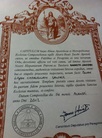 When I came out of the cathedral, it was raining hard. I was exhausted and drained. A man in a red jacket helped me find my way to the Pilgrims' Office. Sort of. Actually, he walked me all the way to the Tourism Office, which was not where I had needed to go, but I did not tell him that. Eventually, I found my own way to the Pilgrims' Office, where I waited an hour in a line that wound through a courtyard and up the stairs of the Casa do Dean to receive my final stamp and Compostela, the official certificate vouching for my spiritual pilgrimage. I unrolled it, once I was outside, to snap a picture of it to send to the gang, and raindrops smeared the ink.
The rest of the day was really hard. I was no longer on the Camino. My way was not way marked and I got lost. And I got lost. And I got lost. My meal cost eighteen euros, and I had nowhere to sleep, and I was afraid I would not be able to find accommodations. Very quickly, Trekkers did not look like Trekkers. They had replaced their faded activewear with regular clothes, had styled their hair, and instead of rucksacks, carried bags full of new toys. I could no longer just follow someone with a beard and a backpack to find my way. And I could no longer disappear into the ferns and brambles to pee. As the afternoon wore on, I grew despondent and my bladder screamed vulgarities.
And I was mad that all the pilgrims had turned back into everyday mortals just like that. Seeing them in their designer clothes was like seeing Hurley and Kate and Jack in their parallel lives.
And where was I going to sleep? My clothes were all dirty, and even if I found a place, it would be too late for my clothes to line dry, assuming it stopped raining. My feet hurt, and it had become clear, during a conversation I had held with a man sitting next to me at the cathedral, that I would not be able to walk to Finnesterre, a continuation of the journey which I had resolved the day before that I would do. The man had explained to me that I would have to walk thirty-five kilometers a day because there were few albergues. I knew thirty-five kilometers a day would not be something I could do.
Eventually I got a room at Casa do Peregrino, which was very close to the cathedral. The room was fifty euros (I probably would have paid the fifty for a pot to have peed in). The receptionist told me that there was no place to wash my clothes and that the next two days would be festival days, therefore, any laundry facilities and all of the stores would be closed.
When I got upstairs, I fell in a heap on the bed, hoping that my phone would have special texts from my husband, applauding me for having accomplished the journey. No texts, because he had not received the notification of my group texts. When we did swap texts, and he asked me how it felt to have arrived, I did not have the heart to tell him. Instead, I floated around the room for an hour on an ocean of tears.
Santiago gives everyone the reception they deserve.
A while later, I shook myself, realizing I would have to figure out how I was going to survive for the remainder of the trip. As previously mentioned, I had booked and paid for accommodations for the last two days, but I would need to secure someplace for the in-between time. I found online that, for twelve euros, I could reserve a bed in a dormitory for the next day at Seminario Menor. I used my debit card and secured the reservation. I then was able to reserve an individual room at the same seminary for the six following days for a hundred and two euros. I did that likewise using my debit card. After all those weeks of walking and walking and waiting in queues, it now took but a few clicks on an IPhone for Hotels.com to secure my sleeping arrangements for the rest of the trip, and all without dipping into my remaining paper euros. To celebrate, I went to a little restaurant and had a piece of cake and a chupita (tiny cup) of crema do oruja.
By the time I got back to my room, Arrival Day had turned to night, and the streets were full of revelry. A drunk man became unruly, growled, and broke glass; and, at some point, authorities had to deal with him.
The streets silenced by midnight. As I fell to sleep, my mood shifted. I began to realize that my room in the Casa do Peregrino had been a gift, even at fifty euros. It had been my own space in which to decompress and to cry like a brat. I slept well until about 3:00 a.m., when I heard someone leaving. "Stinking night walkers," I woke up saying to myself, only to look at my watch and see that it was 8:15 a.m. and to remember that we were no longer on the Camino; no longer waking early to compete for beds.
About fifteen minutes later, I heard the familiar sound of a stick scratching a cobbled street, and I realized the first peregrino of the day was about to arrive at his dreamed-of destination. Soon more scratching. Then chanting. Then singing:
Tous les matins nous prenons le chemin,
Tous les matins nous allons plus loin,
Jour apres jour la route nous appelle,
C'est la voix de Compostelle.
Every day we take to the road,
Every day we forge ahead,
Day after day, the route calls to us,
It is the voice of Compostella.
I sprang to the window and was delighted to discover that the group elatedly singing as they passed under my window was the troop of teenaged French scouts whom I had met again and again on the road. I was so glad that I had had the privilege of watching them reach their destination.
After showering and packing, I left my room a little before noon. I ordered coffee and a croissant at a nearby cafe. The waiter brought me toast and jam. Thin, white American-looking toast, not a hunk of hard day-old baguette. I was relieved. And disappointed.
I spent the next two hours walking to the Seminario Menor, which was to be my home for the next week. After waiting an hour in line for my bed number and package of disposable sheets, I made up my bed, glad to be back sleeping among pilgrims who still looked like peregrinos.
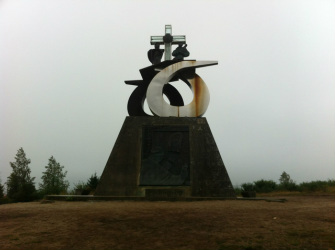 See photo gallery.My having bussed through the Meseta was going to put me in Santiago a week early. I had a room reserved at the Hospederia San Martin Pinario for August 22nd and 23rd, but I was seriously concerned that, with the enormous number of pilgrims who were now on the Camino to walk the last hundred kilometers, I would be unable to find a place to stay in the meantime. As a result, I had reduced the number of daily kilometers I had been traveling. By doing this, it was as if I had gone across the world to perform in a championship running event only to drop to my knees and crawl the last couple of laps, all because I was afraid of what would happen after I crossed the finish line. Seeing it as such, I decided to exercise faith that I would find a place or places to stay and to give it my all and to end triumphantly and strong. Once I made this determination, things again turned for the better. I became excited by the eucalyptus forest and fascinated by the long strips of bark that I saw cast off everywhere like giant brown banana peels. Knowing I was near the end of the deciduous woods and the Camino in its original form, I left rocks that I had brought from home on a deputation marker as my own little cairn. I could not resist kicking a pile of leaves, and I was surprised when they did not flutter, but were heavy like mud. A dog ran up to me, wanting to be petted. That was nice; I just hoped he would not want to follow me. I met him again a few kilometers down the path. I trekked seven hours in the pouring rain, walking behind peregrinos whose plastic rain covers draped over their backpacks made them look like covered camels and walking armchairs.
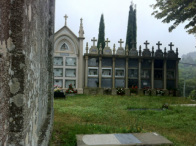 I spent a long time in yet another graveyard outside a little chapel called San Roque, respecting Death's inevitability and allowing deceaseds' ages on their worn tombstones to rattle, sober, tenderize, and gut me.
I passed Lavacola where Medieval pilgrims would purify themselves to prepare for their appearances at the cathedral. In other words, they went to the river and scrubbed their bottoms. Lava means "wash" (as in lavatory) and cola means "tail" (as in colon); so literally Lavacola means "arse-wash."
I saw where people had woven sticks like crosses in the chainlinked fence that went around the airport, but I did not take any pictures, because to me they all looked like they just said TEETH, TEETH, TEETH, TEETH, TEETH.
As I neared Monte del Gozo (Mount of Joy), the place where medieval pilgrims first espied the Santiago cathedral towers which gave rise to its name, I did not feel mounting joy. Instead I felt as if my soul were being squeezed all the more; as if every last drop of oil were being crushed from a sunflower seed; every drop of juice from a grape; every drop of blood from a heart.
I arrived at Monte del Gozo at about 3:00 p.m. I was unable to see the cathedral because of the rain and clouds, but I got a glimpse of Santiago.
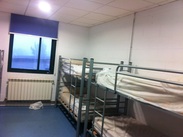 The government-run compound I stayed at on Monte del Gozo was like a flashback from my Russia days. It had five hundred beds in separate blockhouses containing jail cells (oops, I mean, little rooms), with eight beds in each. It had a cafeteria, a playground and a little market, reminiscent also of the run-down Olympic Village at Squaw Valley.
After finishing a made-mostly-with-pork hamburger with a Coke in the cafeteria, I ordered a cafe con leche and a Kit-Kat bar and just sat a while longer at my table. Wishing I could crystalize the evening, I did my best to relax among the roomful of people, who were so full of joyful anticipation as they-- no wait, WE, were only 4.7 kilometers (about three miles) from our destination.
There is a belief that Santiago offers the pilgrim the reception he or she deserves. On the eve of my Santiago arrival, I went to sleep wondering what kind of reception awaited me.
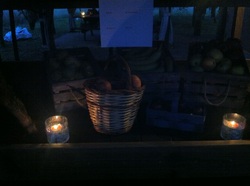 See photo gallery.I left the Arzua albergue at 5:30 a.m. I walked mostly alone in pitch black through deep forest. Owls were screeching. Moth shadows in the flashlight light looked like bats, and the eyes of a raccoon or badger reflected back at me. It was impossible to see the way marks, and I got turned around a few times. I enjoyed it though. It was exhilarating and scary. At one point, beyond the woods, someone had set up a candlelit stand on the path with coffee thermoses and fruit. I came upon it as the sun began to rise. I did not stop to partake, but I did absorb its beauty and serenity. Three and a half kilometers later, I sat under a cherry tree outside a cafe and had a cafe con leche and a tostada with jam. I then walked on another thirteen kilometers. My feet were in such pain, perhaps a difference of walking in mud as opposed to hard dirt, as it had rained during the night. I stopped at the xunta albergue in Santa Irene at 11:00 a.m. It had thirty-six places and was on a busy, noisy highway without meal accommodations. I thought there might be a line of people waiting to get in, but there was no one at the albergue when I arrived. Everyone had likely walked on the additional 2.7 kilometers to the albergue in Arco O Pino which had two hundred beds and places to eat. As I waited, others stopped but then decided to go on, because there was no place nearby to eat. I did not care about food. I just wanted to be assured of a bed and a shower without having to walk farther. After my thirty-five-kilometers-Samos-to-Portomarin day, I was afraid of not finding a place and then having to walk on in pain. After waiting a couple of hours in the pouring rain, the albergue did open at 1:00. The bed had a nice mattress and the place was clean and safe. I, however, was chilled to the bone. I crawled in my sleeping bag first thing to try to get warm. I needed a shower, but, instead hunkered down in my sack to generate some heat.
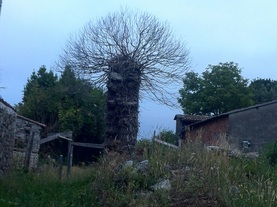 See photo gallery.This morning, I sat under a ceiling of grape vines, drinking a cafe con leche in Castaneda. It was in Castaneda where early pilgrims would deposit the limestone rocks they had brought from Tricastela to be fired for the lime used in the building of the Cathedral at Santiago de Compostela. From Castaneda, I walked through eucalyptus, chestnut, and pine forests before arriving in Arzua, the last major population center I would reach before arriving in Santiago de Compostela. I found Arzua's layout to be haphazard and untidy. In front of the Fourteenth Century Augustinian Capilla de la Magdalena was the modern parish, which had been dedicated to Saint James and which had an image of Santiago as a moor slayer and pilgrim. Behind the modern parish was the government albergue that I had been looking for.
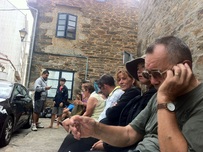 I arrived at the xunto albergue about 11:00 a.m. and waited in a queue for its opening at 1:00 p.m. I put my backpack in the packs line then sat on a stoop. Knowing from guide books that there were forty possible places at this albergue, Trekkers hoping for beds would count the packs in the line to determine whether they would get a place or whether they would need to walk on.
I sat in the crowd with my eyes closed, listening to Joshua James in my headphones. I did not try to make eye contact with anyone or to chitchat. I knew I should, but it seemed to take more effort than I was capable of mustering. Furthermore, it seemed pointless. For days, people had been giving me the same look which said to me that they thought I was an 'oddity.' Quite frankly, I had become tired of trying and had surrendered to just being "other."
A young Asian man wearing a long-sleeved neon-green running shirt and black Craig Hoppers approached the queue, looking like he felt as miserably awkward as I. He counted and recounted the backpacks before realizing that his was the forty-first. When next I looked for him, I saw that he had taken his lonely other-ness down the road.
An hour or so later, the hospitalera opened the door. I shuffled inside with the group. After paying my five euros for the night's shelter, I went upstairs. I put my boots on the boot rack, went into the dorm, slipped my pillow into its disposable case and spread my paper sheet over my lower-bunk mattress.
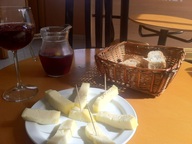 I had read that Arzua was known for its local cheeses and its annual cheese fair, Festo do Queixo, so, after napping and showering (again without a shower curtain), I set out to find a cheese plate and a glass of sangria for dinner and some grapes and oranges to take with me on the next day's hike.
Over dinner, and while wandering the town, I thought about how Saint James' Way was supposed to be a universal path where acceptance smoothed over people's trivial differences, and I wondered why, if that were the case, I felt so foreign. But then I thought about how I felt almost as alien in my own country and how I simply did not know how to be comfortable around others. I thought about how I have always been able to close my eyes and to exist in uncomfortable situations, but how I did not know how to keep my eyes open and to truly live in even comfortable situations. I long to know how to love others. I really do. It just seems to be beyond my ability. It is not because I am a cranky selfish person. It is because I am afraid of others. Unfortunately, on the Camino, I have thus far discovered how easy it is to put in earbuds, to listen to music, and to not connect with others. I believe, therefore, that the remainder of this journey surely will be about learning how to share joy with others and to give a little kindness, a smile, and a helping hand.
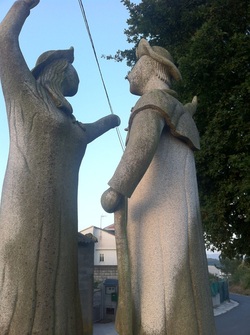 See photo gallery.I felt better when I woke up. I had gotten dehydrated and then chilled when I had sat wearing a sweaty t-shirt in the cool shade waiting for the albergue to open yesterday. I got out and on the road early. With the masses traveling, people were leaving the albergues by 4:00 in the morning. I could not have slept until 6:00 or 7:00 if I had wanted to. I walked twenty-two kilometers, farther than I had planned, before stopping at a private albergue in Boente. Between Palas de Rei and Boente, I passed Galician granaries, pilgrim hospital ruins, churches, horses, barns, and cemeteries, every bit of the way smelling noxious, sweet manure. Having taken my backpack off before entering a church in Melides, I lost my borrowed IPod Nano. The hospitalero in Boente was a good host, waiter, and business man. I loitered in his cafe some that afternoon, sipping a Coke and watching the Olympics, which were playing everywhere. It was strange to watch them in a country where the U.S. was hardly featured, alongside viewers who were cheering for every team but the U.S.
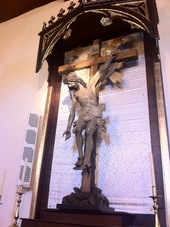 While in Boente, I visited the church across the highway, then took a walk toward the sun.
Outside a cafe, a seventy-four-year-old man named Xuan asked me to sit and have a drink with him. Having just had a Coke, I declined the drink, but I gladly sat down with him, and we visited for a half hour or so. Xuan was Galician. He had grown up in this village. His father and grandfather had been blacksmiths. His family had raised pigs and had grown all of their own food. He told me how his mother had "bought sugar or a fish maybe once a month."
When Xuan was twenty, he had moved to London, where he first worked as an orderly in a hospital and then as a switchboard operator for nearly thirty years. He, his wife, and his son came back to Galicia in 1986. He still owns the home in London which he rents out as well as a home near Santiago. Xuan went on to tell me how he comes to Boente a few times a week. Pointing beyond the highway that now runs through what, back then, had been fields and narrow roads, he showed me which house in the village was his and which was the home that he had grown up in.
Having recently had heart surgery, Xuan had much to say about life and about what really mattered to him, "What matters is that we are kind and helpful to others," he said, and furthermore, "We should have enough, but not live extravagantly and not be greedy."
I went to sleep that night thinking about Xuan's story and contemplating the impermanence of my own earthly form. I prayed that going forward, every step I make will be a prayer for understanding; every breath I take, a whisper of gratitude; and every moment, a chance to awaken from the dream that has kept me separate from my eternal source.
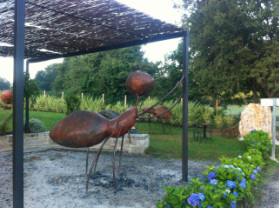 See photo gallery.I wound up getting no sleep last night. I thought that the top bunk I had selected would be great. Against a partial wall, it had had a bit of privacy. And it was wonderful for the while that I had spent listening to music as the others settled in before the lights went off. But that was where the comfort ended. My specially chosen spot wound up being under two blaring sets of night lights. I listened for hours as a couple of others likewise tossed, then, at about 3:00 a.m., I started to drift to sleep, in time for a rooster below the window to begin his rude performance. Two hours later I arose with a sore throat. Listening mostly to music by Lana Del Rey, I walked from Ligonde to Palas de Rei. As soon as I reached the city's center, I stopped at a supermercado and bought a bottle of shampoo, some cheese, a bag of throat lozenges, some cookies, and an ice-cream bar. After finding the government albergue, I ate the cheese, cookies, and ice cream while waiting in a queue for a bed. I got the shivers as I waited three hours in the shade, so, as soon as I got a bed, I went right to sleep.
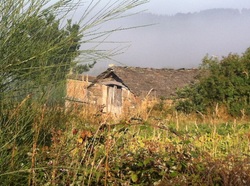 See photo gallery.I saw the Little Gray-haired Schoolgirl at the cafe in Gonzar. He later passed me again in Ligonde. I was fascinated by him. He was so different than everyone else. He smelled strong of an Irish-Spring-type soap and carried a wooden pole. His gray hair was long but cut into shaggy layers. His pleated navy and green plaid skirt fell mid-calf, and he had a blue band on his left leg. He rolled his socks down like bobby socks and wore an untucked short-sleeved shirt like a blouse. That was all I knew about him, but I wished I knew more. I arrived in Ligonde about 11:00 a.m. I got in a queue in order to try and get a place at the government albergue. There were so many peregrinos on the road now; the only real chance of getting a place was by arriving very early and waiting hours for the facility to open. My backpack was third from the first in the row of backpacks lined up outside the albergue door. In no time at all another sixteen were lined up behind mine. The albergue only had twenty beds. So, for the next hour and a half, pilgrims hoping to stay would stop, count the backpacks lined against the wall, then dejectedly move on. A very nice French psychologist visited with me in English for the while that we were waiting for the albergue to open. He was traveling with his grandson and was congenial and funny. After the albergue opened, I rested while the others showered. There was no point in racing to the bathroom just to wait some more. Unfortunately, while I was lying there, a teenaged couple got into a terrible argument. It was just them and me in the dorm, and, for the sake of their privacy, I pretended to be asleep. Eventually, I was. If only for a few minutes. When I awakened a bit later, more folks had filled the dorm, and the teens had taken their turmoil elsewhere. I went to the bathroom to shower and wash my clothes. I opened the bathroom door, and the women in there stared at me like I was a Little Gray-Haired School Girl.
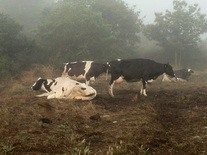 I was tired of that. What was so darned curious about me anyway? Early on in the journey, it had felt like we were all in this together. Since the masses had come aboard, the Camino's complexion had changed though. I felt more connections with the cows and the dogs than with the people. How could I obey the Good Book and love others as myself when I did not like others very much? Maybe I loved them as much as I loved myself after all; maybe the real problem was that I did not love me. At any rate, I seemed to care enough for myself to seek self-preservation, so maybe I could start by at least doing what I could to try and preserve others' dignity and sanity.
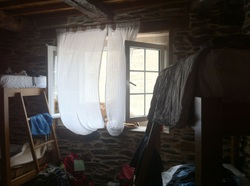 See photo gallery.I was one of the last to leave the gym. Albergues make you leave by 8:00, but there was no such rule imposed at the gym. I was not in a rush to go anywhere this day anyway. So I stayed in the interesting port town a while, found a pharmacy, and had a cup of coffee and a slice of almond torte in a cafe overlooking the water. I did not travel far. In fact I stopped at about 1:00 p.m. at the first albergue I came to in Gonzar, a rustic village with bull flops, cracked asphalt and dairy cows. Along the way, I thought about how much I liked the smell of jelly beans. Either it was a silly rogue thought that had gotten stuck in my head or it was Freudian due to my nose having been filled for hours with the sweet smell of bull manure. Although I did not like the smell, I did not mind it, because the smell always told me that I was getting close to people and to the possibility of food and rest. I had read that Galician people burn the peat for their fuel. I do not know if that is true, but, when I had eaten in the people's backyard near Fort Lusio, I had found that the dried meat they had served me actually had tasted the way bull pucky smells. Also along the way, I noticed how few children were in the villages and how Galician old people hobble around their gardens using pilgrims' cast-off trekking poles instead of canes. I encountered a couple whom I had traveled near to now and again between O'Cebreiro and Tricastela, and I listened again and again to roosters' demanding cockadoodles, which reminded me of my son's dog's bossy rhy-rhah-rhoh-rhoooahing for peanut butter in his kong. In Gonzar I stayed at Casa Garcia, a spotless operation with several young girls serving meals in the cafe and other people cleaning and cooking. It had a beautiful partially covered courtyard with a spotless restaurant. The dorm had very nice wooden bunk beds with enough space between the bottom and top bunks to sit up in while on the bottom bed.
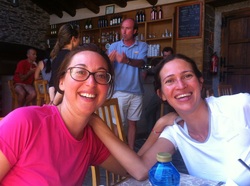 After showering and taking a short rest, I had a meal in the albergue's courtyard. I kind of wanted to try the pulpo (octopus), but I really did not want to spend twelve euros on something that I probably would not like. Instead I ordered a salad, bisteak, potatoes, and flan with an orange-amber-colored Estrella Galicia beer. I have never been a beer drinker (somehow I got it in my head that beer is not a ladylike beverage), but this was the second I had had on the trip. I liked the way it tasted and even more so how it felt going down: cold and fluffy, like it was sudsing up my insides.
Because my table had two extra chairs and was the only table in the shade, two Barcelonian girls asked me if they could join me for lunch. The day was their first on the Camino. Though they were tired, they were happy, and I greatly welcomed their enthusiasm.
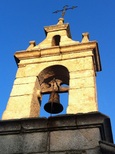 Mid-evening, I walked to the church with its little cemetery. I thought about how differently we might approach church if we were to have to walk past sepulchres every time we entered our churches to worship. I spent a lot of time reading the engravings above the tombs and I was mindful of life's standard chunk of years and of families' grouped deceased. I spent a good while pondering these things and desperately wishing to restore and enliven my own family relations so that we might make the most of what years we all have left together.
When I got back to the albergue, I got ready for bed and crawled into my sack. Others were softly talking. When the lights went off I was listening in my headphones to modern hymns by Ascend the Hill. I had been really splayed open this night, grieving my own losses, while at the cemetery. I started to softly weep. By then It was quiet in the dark. I put my head inside my sleeping bag and bit my cheek. I did not want the others to know I was crying. I held my breath, but soon my packed sinuses rattled. I desperately wanted to disappear. I felt so sad and pathetic in that sleeping space of strangers. For an hour more, in the silent darkness, I labored to conceal the ache-sounds before I finally drifted off to sleep.
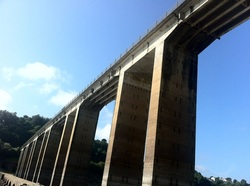 See photo gallery.I had a dickens of a time finding a place to stay on this day. The day had started well, with me being overjoyed that I had to cinch up my now-too-big shorts with an extra boot lace, but the joy lessened considerably a couple of hours later, when I could not get the knot untied while dancing from foot to foot in the six-foot-ferns-and-thorny-primrose powder room. I arrived at San Mamed by 10:00 a.m., but it was way too early to stop, so I kept walking to Sarria, where I arrived by noon and once again ran into the giddy French teen scouts. I should have stopped there and then, but, because I still had plenty of energy, I chose to soldier on to Barbadelos. What a mistake, as every albergue beyond Sarria was full! I galumphed along monster-like as fast as I could from town to town, randomly thinking things like, "How funny it is that a cow is braying in Brea"; "Eight euros is an awful lot for a peregrino to have to pay for a horse stall to bed his horse"; "That gray-haired man in the plaid skirt up ahead looks like he is wearing a Catholic school girl outfit" and that sort of rot. "Completo." Next town. "Completo." Next town. "Completo." Now and again I would encounter the same Spanish family of Trekkers on the road. Each time, the father, worried about my foot, would tell me to slow it down. I would smile, nod, and thank him for his concern, but the truth was I could not afford to slow down, because every minute I fell behind others was a bed l would lose at an albergue and more kilometers I would have to walk on. I walked awhile with an Irish school teacher named Yvonne. She was very pleasant and caring and was a terrific lot of fun to chat with. I was sorry when her friends urged her onward, away from pokey me. She said that they had a lot of kilometers which they were hoping to cover that day. Little did I know at that point that I would wind up having just as many. Twenty-six kilometers later, I stopped at a cafe in Ferrerios, where I had a bowl of caldo gallega, a salad, a slice of almond torte, and a couple glasses of water. It was the first time I had eaten all day. The cafe owner told me that he had heard all of the albergues in the next town were also full. By the time I finished my meal, it was 6:00 p.m. Realizing the prospects of finding a bed were slim, I got back on the road anyway and began to walk the next nine kilometers to Portomarin. What else could I do? "Every day is something different," I thought, "a new challenge." Strangely, I was not too worried, because I was growing to be open to what each day on the Camino offered. That said, I realized there was a very good chance I would be sleeping outside that night and that it would be spooky and cold. "At least the moon is big," I consoled myself and then wondered if there would be wolves. Although my foot fiercely hurt, I enjoyed the walk very much. It was the first time that I had faced a lowering sun and had walked toward longer and skinnier shadows. Furthermore, as the hard trail loosened, sparkles began to peek out of the sand, which made me think of my dad. All along the Camino I had felt him-- in the sun on the ripened grain, in the summer rain, in the scent of farmland soil, in the morning's hush, and now here in the diamond glints in the sand. On I hiked to Portomarin, singing aloud to old Keith Green hits. The last stretch I walked was across a long skinny bridge high, high, high above a waterway. It was terrifying. I could not look down. There were horses in the grass at the water's edge, but I could not look over the edge to take their pictures or to even look at them.
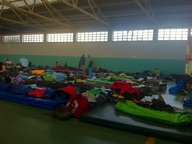 About 8:30 p.m., I arrived in Portomarin. As expected, I found all of the albergues full. As I wandered the streets, looking for a place to stay, a kind young man saw me and brought me to a sports gym, which was filled with peregrinos who had been unable to find shelter elsewhere. Drippy clothes hung on makeshift clothes lines around the gym. Exhausted peregrinos washed up in locker rooms and rested on royal-blue gym mats. The young man who had brought me there told me to take his mat, but I found another. He then brought me medicine gel to put on my foot.
An old man whom he was with then came to me and told me to take three long deep breaths. He said something more to me in Galega, which I did not understand, and then he laid his hands on my foot and did his own breathing thing. Right then and there, the old man drew all of the pain from my foot! I have yet to know what happened. I had read stories before going on the trip about Galician healers and their miracles. Was this man a healer? Had he performed some kind of hypnotherapy? All I knew was that I was tremendously relaxed after he had finished his treatment and that he seriously had taken all of the pain out of my foot.
As the afternoon had worn on, I had been reassured again and again in my spirit that it would all be okay. In fact, I actually had been expecting some kind of surprise. My foot had been quite bad. Throughout the entire trip I had asked God to teach me to master my pain as a mind-over-matter thing. I had been unsuccessful mastering the pain as such, but, even so, there had been a provision for my pain on this day. While I surrendered to the old man's miraculous therapy, I knew that his was the surprise I had been waiting for.
All in all, I walked thirty-five kilometers (twenty-two miles) from just-beyond Samos to Portomarin this day. Thirty-five kilometers was way too many miles for my bad foot; regardless, the day was filled with zest, grace, magic, esteem-bolstering, delicate memories, and spiritual intimacy. Quite lovely, really.
|




















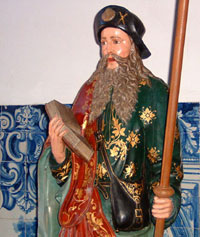
 RSS Feed
RSS Feed